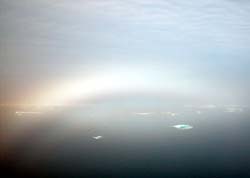|
|
 |
Images
and Facts - Facts
Gallery | Dispatch
Images | Facts | References
Optical Effects
by C. A. Linder
Aurora Borealis
The aurora borealis, or northern lights, is a shimmering curtain of
light which can be seen in the clear night sky in the Arctic when
solar energy is strong. Auroras are produced by the interaction of
the solar wind (a stream of protons and electrons from the sun) with
oxygen and nitrogen atoms in the earth's atmosphere. Auroral displays
are centered in a ring around the geomagnetic pole, but can be seen
many thousands of miles away. The fantastic light shows range in altitude
from 40 to 120 miles above the earth's surface. The color ranges from
high-altitude red displays to the more common, low-altitude yellow-green
displays.
Halos
Halos are bright arcs or spots of light which form due to the reflection
and refraction of light passing through ice crystals. Ice crystals
are commonly found in cirrus (high, thin, wispy) clouds and in ice
fog. Halos can be seen anywhere in the world, but are extremely common
in the polar regions due to the cold air (ice crystals are much more
common). The type of halo encountered is mainly dependent on the orientation
of the ice crystals in the atmosphere.
The 22° Halo
This is the most common type of halo. It appears as a thin whitish
circle centered around the sun or moon. If you draw a line from your
eye to the edge of the arc, the angle between this line and a line
drawn straight into the sun would be 22°. The ice crystals for this
kind of halo are oriented randomly in the air.
Sun Dogs
Sun dog is another name for a halo called parhelia. Parhelia are bright
spots seen in cirrus clouds at the same altitude as the sun. Although
similar to the 22° halo, the spots are considerably brighter.
The ice crystals that cause parhelia are oriented horizontally.
 |
 |
Arctic Ocean fogbow.
photo © C. A. Linder, WHOI |
Fogbow
A fogbow is a rare form of rainbow. Rainbows are formed by the refraction
of light through water droplets. The larger the water droplets, the
more the light is "bent" and the brighter the colors of
the rainbow. If the droplets are very small, such as those in fog,
interference causes the colors to blend into a pure white -- the fogbow.
Anticorona (Glory)
The anticorona, also known as a "glory" occurs at the point
opposite a source of light. It is made up of one or more colored rings
that appear around the shadow cast by an observer on a cloud or in
fog. An image from the 2002 cruise here is an example of a glory. Glories can also be observed from airplanes.
Researcher Dan Torres observed glory rings around the shadow of the
Coast Guard helicopter he was flying in as they passed over a fog bank on the way to the ship in 2002.
Mirages
A mirage is a false image formed by the refraction, or bending, of
light. There are several types of mirages. The most common type of
mirage is an inferior mirage. These can be seen on any warm surface,
such as a highway. The shimmering pools of "water" are actually
blue skylight whose rays have been refracted upward by the layer of
heated air above the asphalt. It is called an inferior mirage because
the flase image occurs below the real image. Another type of mirage
is a superior mirage. This image occurs above the real object. In
contrast to inferior mirages, superior mirages occur when warm air
overlies cold air.
 |
 |
Fata morgana mirage
observed on the 2002 cruise.
photo © C. A. Linder, WHOI |
Fata Morgana
The fata morgana is a superior mirage formed when a layer of warm
air overlies a cold surface (known as an inversion). Inversions form
frequently in the Arctic in summer when warm air travels (is advected)
over the cold water and ice. The light is bent in such a way that
distant ice appears to rise vertically out of the horizon. The term
"fata morgana" comes from the Italian for "fairy Morgan,"
the half-sister of King Arthur. Legend has it that Morgan lived in
a crystal palace underwater, and could use magical powers to build
castles out of thin air.
Back to Facts Index
|
|




